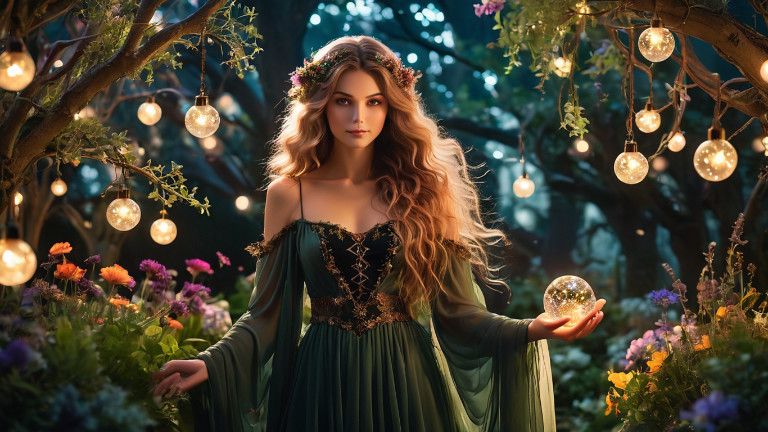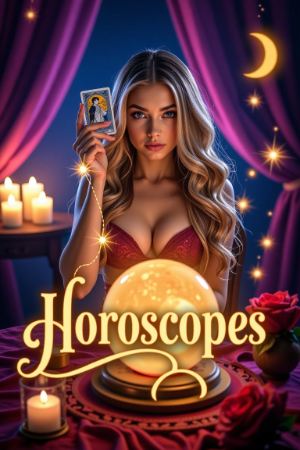
If you’ve ever felt a pull towards the mystical and the macabre, or if the beauty of the night speaks to your soul, you might find your true calling as a Gothic witch. This guide is designed to help you explore this fascinating path, offering practical steps and insights into embracing your inner Gothic witch.
Becoming a Gothic witch isn’t just about adopting a certain look or style—it’s about cultivating a deep connection with the unseen and finding beauty in the shadows. Whether you’re new to the world of witchcraft or looking to deepen your practice, this guide will walk you through the essentials of Gothic witchcraft. We’ll cover everything from the aesthetics and tools to the rituals and community aspects that make this path unique.
Gothic witches are not creatures of inherent evil; rather, they are individuals who wholeheartedly embrace the shadowy aspects of witchcraft and magic. Their practice is a reflection of the profound understanding that darkness holds its own unique power and beauty, much like the mysteries concealed within the veil of night. It’s not about malevolence but rather about tapping into the potent energies of nighttime magic—the subtle whispers of the moon, the secrets whispered by the stars, and the profound wisdom hidden in the depths of darkness. In essence, Gothic witches walk the intricate path between light and shadow, finding balance and strength in both realms as they weave their enchantments and explore the depths of their own souls.
So, if you’re ready to dive into the world of Gothic witchcraft, read on. This journey is about more than just spells and rituals; it’s about embracing your own unique magic and finding empowerment in the darkness. Let’s embark on this mystical adventure together, discovering what it truly means to be a Gothic witch.
What is a Gothic Witch?

A Gothic witch is a practitioner of witchcraft who embraces the dark, mysterious, and often romantic aesthetics of the Gothic subculture. This path combines the ancient traditions of witchcraft with the deep, brooding elegance of Gothic style. Gothic witches find beauty in the shadows, draw power from the night, and connect with the mystical and arcane aspects of life. They are often seen as the bridge between the ancient magical traditions and the modern, urban landscape.
Gothic witches are known for their unique approach to magic, which often includes elements of Victorian and medieval aesthetics, dark poetry, and an appreciation for the macabre. Their practices may involve rituals performed under the moonlight, the use of black candles and crystals, and a deep reverence for the mysteries of life and death. Unlike traditional witches, Gothic witches weave their spells with a touch of melancholy and a love for the darker side of nature and the human psyche.
How to Become a Gothic Witch
Step 1: Embrace the Gothic Aesthetic
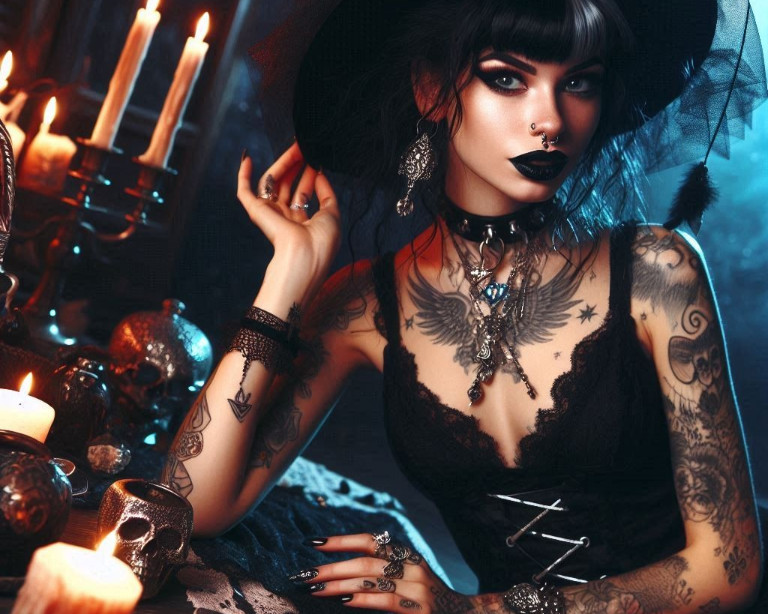
To become a Gothic witch, the first step is to immerse yourself in the Gothic aesthetic. This means embracing dark, elegant clothing, often in shades of black, deep reds, purples, and midnight blues. These colors not only resonate with the Gothic style but also evoke a sense of mystery and depth, aligning with the inner journey you’re about to embark on. Choosing fabrics like lace, velvet, and leather can add richness and texture to your outfits, making you feel both powerful and enchanting.
Incorporate elements of the occult into your wardrobe to further deepen your connection to the Gothic witch identity. Accessories play a crucial role here—think pentagram necklaces, rings adorned with raven motifs, or earrings shaped like skulls. These symbols are not just for show; they carry deep meanings and can serve as talismans in your magical practice. By wearing them, you signal to the world—and remind yourself—of your commitment to the Gothic witch path.
Your outward appearance is a reflection of your inner transformation. As you embrace the Gothic aesthetic, you may find that it influences not just how others see you, but how you see yourself. Dressing in a way that feels authentically Gothic can help you tap into a deeper part of your psyche, one that is in tune with the shadows and the mysteries of the night. This visual transformation is a powerful step in aligning your external world with your internal magical practice.
Furthermore, embracing the Gothic aesthetic is about more than just clothing and accessories. It extends to your personal environment as well. Decorate your space with items that resonate with the Gothic vibe—black candles, antique mirrors, dark floral arrangements, and mystical artifacts. Creating an environment that reflects the Gothic aesthetic can enhance your magical practice, making you feel more at home in your own skin and more connected to the energies you’re working with. This holistic approach ensures that the Gothic witch aesthetic permeates every aspect of your life, providing a constant source of inspiration and empowerment.
Step 2: Create a Sacred Space
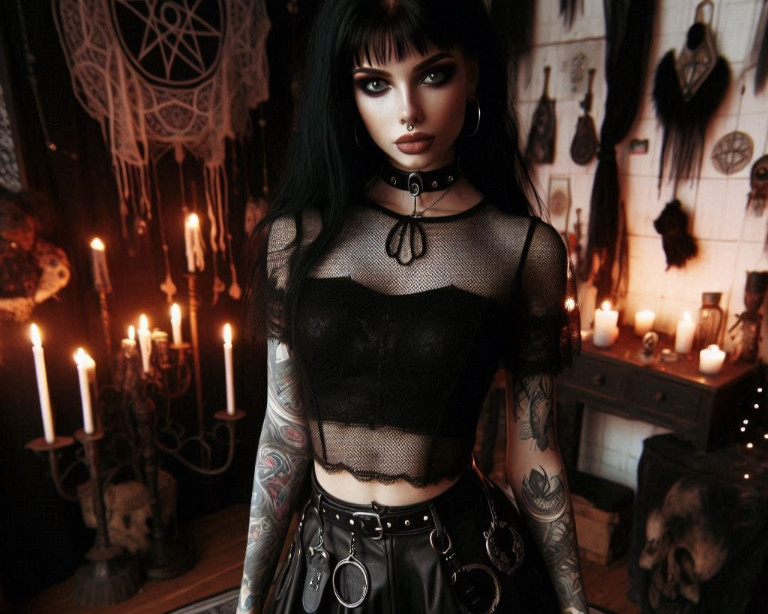
Every witch needs a sacred space where they can practice their craft and connect with their inner self. For a Gothic witch, this space should reflect the dark elegance of the Gothic aesthetic. This sacred area becomes the heart of your magical practice, where the physical and spiritual worlds converge. Start by choosing a quiet, undisturbed corner of your home that you can dedicate solely to your witchcraft. This could be a small table, a shelf, or an entire room, depending on your living situation and available space.
Decorate your altar with items that resonate with the Gothic aesthetic and your personal energy. Black candles are essential, as they symbolize protection, power, and the mysteries of the night. Antique candelabras not only add a touch of historical elegance but also enhance the ambiance of your rituals, casting flickering shadows that create a mystical atmosphere. Incorporate crystals like obsidian and amethyst, which are known for their protective and spiritual properties, respectively. These crystals can help you ground your energy and enhance your psychic abilities.
In addition to the basics, personalize your sacred space with items that hold meaning for you. Tarot cards can be a powerful tool for divination and self-reflection, while herbs such as sage, rosemary, and lavender can be used in spells and rituals. Spell books and grimoires, whether handwritten or printed, provide a wealth of knowledge and can be a source of inspiration and guidance. Consider adding objects that symbolize your personal journey, such as feathers, bones, or antique keys, which can serve as reminders of your connection to the past and the unseen realms.
Your sacred space is more than just a physical area; it’s your sanctuary, a place where you can retreat from the mundane world and connect with the spirit world. Use this space to perform rituals, meditate, and deepen your practice. Light candles and incense to create a calming and focused environment. Spend time here daily, even if it’s just for a few minutes, to center yourself and recharge your energy. By consistently nurturing your sacred space, you cultivate a powerful environment that supports your growth as a Gothic witch and strengthens your bond with the magical world.
Step 3: Study Gothic Literature and Poetry
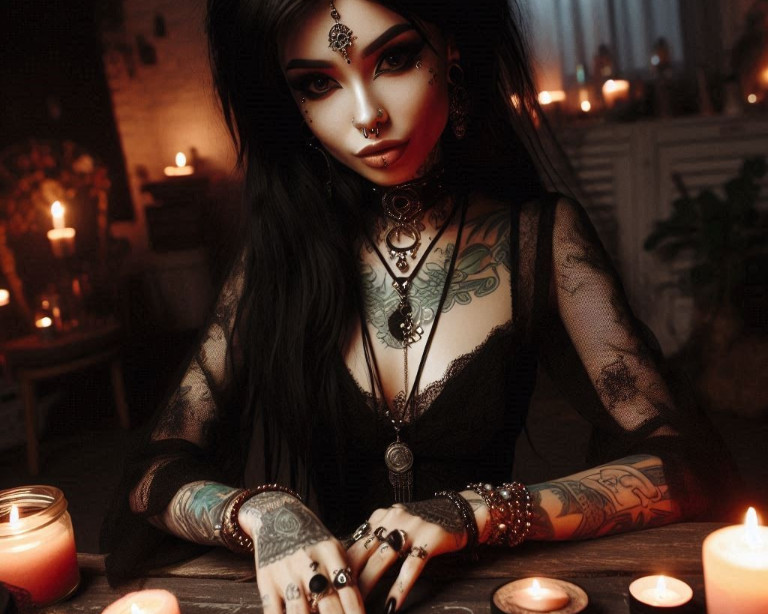
Gothic literature and poetry are rich with themes of mystery, the supernatural, and the macabre. These literary works delve into the darker aspects of human experience, exploring themes that resonate deeply with the Gothic witch’s path. Begin your journey with the haunting tales of Edgar Allan Poe, whose works such as “The Raven” and “The Tell-Tale Heart” explore themes of madness, death, and the supernatural. Mary Shelley’s “Frankenstein” is another cornerstone, offering profound insights into the nature of creation, identity, and the consequences of delving into forbidden knowledge. Bram Stoker’s “Dracula” introduces you to the classic world of Gothic horror, filled with eerie landscapes, tragic love, and the allure of the night.
Reading these works not only enhances your appreciation of the Gothic aesthetic but also deepens your understanding of the archetypal themes that shape the Gothic witch’s worldview. The haunted castles, forlorn characters, and eerie settings in these stories provide a rich tapestry of inspiration for your own magical practice. The struggles and triumphs of these characters can mirror your own journey as a Gothic witch, offering valuable lessons on resilience, transformation, and the power of the unseen.
In addition to classic literature, explore Gothic poetry to immerse yourself in the language of the macabre and the mysterious. Poets like Christina Rossetti and Lord Byron weave words into hauntingly beautiful verses that evoke the spirit of the Gothic. Rossetti’s “Goblin Market” and Byron’s “Darkness” are excellent examples of how poetry can capture the essence of the Gothic witch’s experience—balancing beauty and terror, light and shadow. These poems can serve as powerful incantations or meditative readings, enriching your rituals and spells with their evocative imagery and emotional depth.
Let the tales and verses you read fuel your imagination and inform your magical practice. Use the settings and characters as inspiration for your rituals, drawing parallels between their journeys and your own. Create spells and incantations that echo the themes of the literature you study, incorporating elements of mystery, transformation, and the supernatural. By immersing yourself in Gothic literature and poetry, you not only enrich your understanding of the Gothic witch’s path but also tap into a timeless source of wisdom and enchantment that will continually inspire and guide you.
Step 4: Learn the Basics of Witchcraft
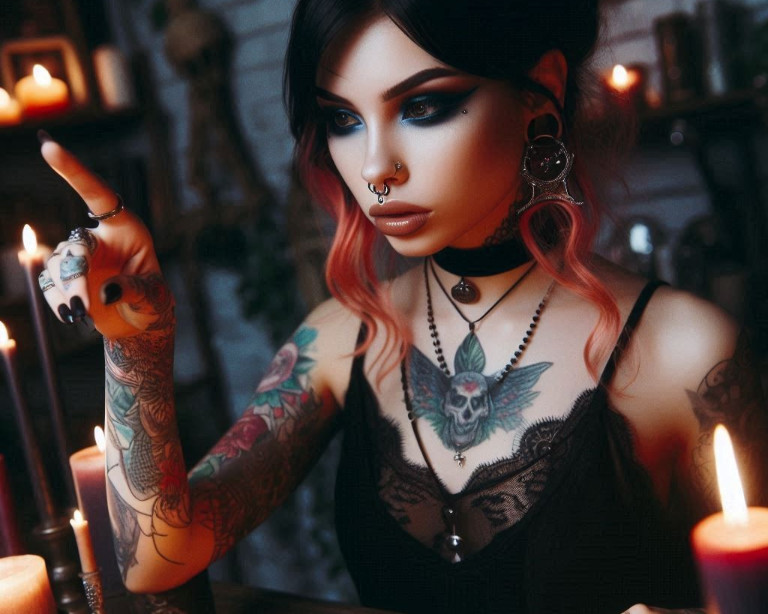
Before you can delve into the unique path of Gothic witchcraft, it’s essential to build a strong foundation by learning the basics of witchcraft itself. This journey begins with studying the rich history and diverse traditions of witchcraft. Understanding where witchcraft comes from and how it has evolved over time will give you a deeper appreciation of your craft. Research the practices of ancient cultures, the development of witchcraft through the ages, and how modern witchcraft draws from these historical roots. This knowledge provides context and depth to your practice, connecting you to a long lineage of magical practitioners.
A key aspect of witchcraft is the use of magical tools, such as herbs, crystals, and other sacred objects. Herbs like sage, rosemary, and lavender have been used for centuries in spells and rituals for their protective, cleansing, and healing properties. Learn about the different uses of these herbs and how to incorporate them into your practice. Similarly, crystals like quartz, amethyst, and obsidian can enhance your magical workings. Each crystal has its own unique properties and energies; understanding these can help you choose the right ones for your spells and rituals. Familiarize yourself with how to cleanse, charge, and use these magical tools effectively.
Spells and rituals are at the heart of witchcraft, serving as the methods through which you channel your intentions and connect with the mystical forces around you. Start by learning the different types of spells, such as protection spells, love spells, and healing spells. Understand the components that go into creating a spell—like intention, focus, and the use of specific ingredients or tools. Similarly, rituals can range from simple daily practices to elaborate ceremonies marking significant events. Learn how to create a sacred space, cast a circle, and call upon the elements during your rituals. Practicing these basic techniques will build your confidence and skill as a witch.
The moon phases and the elements are fundamental concepts in witchcraft, deeply influencing the timing and nature of your magical workings. The moon’s phases—new, waxing, full, and waning—each carry different energies that can enhance specific types of magic. For instance, the new moon is ideal for new beginnings and setting intentions, while the full moon is a powerful time for manifestation and completion. Additionally, the four classical elements—earth, air, fire, and water—represent different aspects of nature and can be invoked in your spells and rituals to bring balance and power. Understanding these cycles and elements allows you to align your practice with the natural world, making your magic more effective and harmonious. By mastering these basics, you lay the groundwork for developing your own unique practice as a Gothic witch.
Step 5: Connect with the Moon and the Night
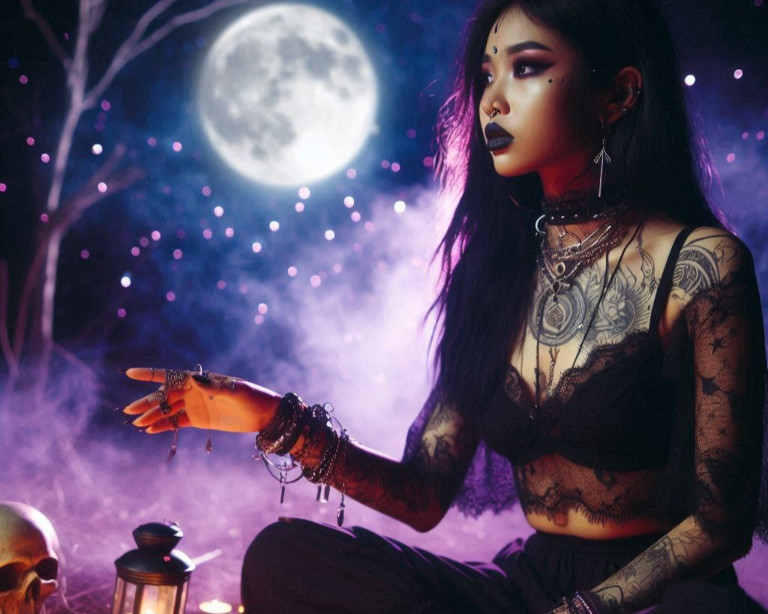
Gothic witches draw much of their power from the night and the moon, both of which hold a profound mystical energy that can enhance your magical practice. To truly connect with these natural forces, make it a habit to spend time outdoors under the moonlight. This can be as simple as taking nightly walks or sitting quietly in your backyard, allowing yourself to soak in the moon’s light. By consistently immersing yourself in the night, you will begin to feel its calming and empowering presence, which can be a source of great inspiration and strength for your witchcraft.
Observing the phases of the moon is a crucial part of connecting with lunar energy. Each phase—the new moon, waxing crescent, first quarter, waxing gibbous, full moon, waning gibbous, last quarter, and waning crescent—has its own unique energy and significance. For example, the new moon is a time for new beginnings and setting intentions, while the full moon is perfect for manifesting goals and performing powerful spells. Keep a moon journal to track how each phase affects your energy and your magical work. This practice will help you align your spells and rituals with the moon’s cycles, enhancing their effectiveness.
Performing rituals and meditations at night can deepen your connection to the moon and the mystical energies of the darkness. The quiet and solitude of the night create an ideal environment for introspection and spiritual work. Try meditating under the moonlight, focusing on its gentle illumination and the way it transforms the night. Use this time to clear your mind, set intentions, or simply connect with the lunar energy. Nighttime rituals can include lighting candles, using moon water, and invoking lunar deities. These practices can help you tap into the moon’s guidance and illumination, enhancing your intuition and magical abilities.
The moon is a powerful ally for the Gothic witch, offering both guidance and illumination in the darkness. Its cyclical nature teaches us about change, renewal, and the balance between light and shadow. By forming a deep connection with the moon, you can draw upon its power to enhance your spells, rituals, and personal growth. This relationship is not just about using the moon’s energy but also about respecting and honoring its presence in your life. Embrace the moon as a constant companion on your Gothic witch journey, and let its light guide you through the mysteries and magic of the night.
Step 6: Incorporate Music and Art
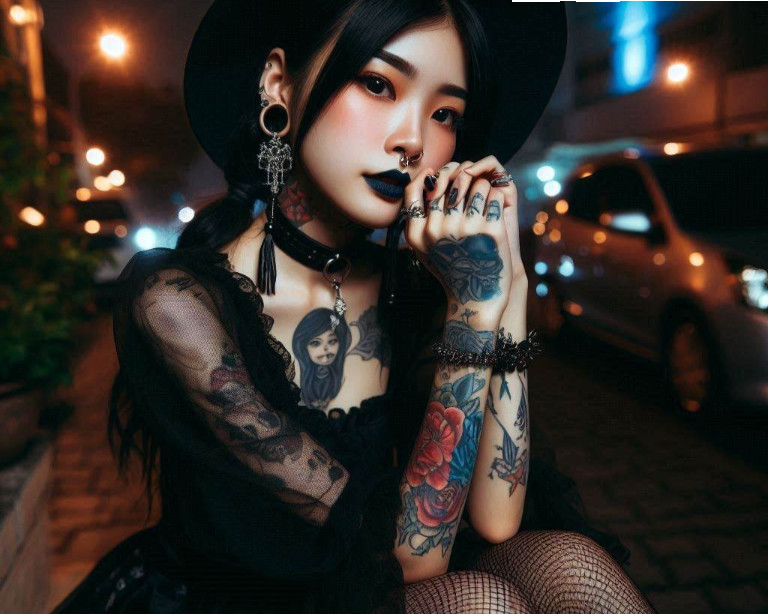
Music and art are powerful tools for expressing and enhancing your Gothic witch identity. They have the ability to evoke deep emotions, inspire creativity, and connect you with the mystical aspects of your soul. Start by exploring different genres of music that resonate with the Gothic aesthetic, such as Gothic rock, darkwave, and ethereal music. Bands like The Sisters of Mercy, Bauhaus, and Dead Can Dance offer a sonic landscape that can set the perfect mood for your magical work. Listening to this music while you meditate, perform rituals, or even just go about your daily tasks can help you stay connected to your Gothic witch persona.
Creating or collecting art that reflects the Gothic aesthetic is another way to deepen your practice. Look for dark, romantic paintings, eerie photographs, or sculptures that evoke a sense of mystery and otherworldliness. Art that features themes like haunted landscapes, forlorn figures, or mythical creatures can serve as a powerful visual reminder of your connection to the Gothic witch path. You might also consider creating your own art, using mediums like charcoal, ink, or digital tools to express your inner darkness and magical visions. This creative process can be incredibly cathartic and illuminating.
Use music and art to enhance your rituals and magical practices. For example, you can create a playlist of Gothic music to play in the background during your spells and rituals, helping you to enter a trance-like state and deepen your focus. Art can be integrated into your sacred space or altar, providing visual stimuli that inspire and guide your magical workings. You might also incorporate artistic elements into your spells, such as drawing sigils, painting representations of your intentions, or crafting talismans. These artistic expressions can make your magic more personal and potent.
Finally, let music and art help you connect with the deeper aspects of your soul. Engage with these mediums not just as background elements, but as active components of your spiritual journey. Attend live performances, visit art galleries, or participate in creative workshops to immerse yourself in the Gothic artistic community. These experiences can open new pathways for inspiration and self-discovery. By weaving music and art into the fabric of your daily life and magical practice, you enrich your experience as a Gothic witch, allowing your creativity and spirituality to flourish together.
Step 7: Develop Your Own Rituals and Spells

As a Gothic witch, it’s important to develop your own unique rituals and spells that reflect your personal beliefs and aesthetic. This process is deeply personal and allows you to connect with your inner self and the energies around you in a way that resonates with your Gothic sensibilities. Start by exploring traditional witchcraft practices and then adapt them to incorporate elements that speak to your Gothic nature. This might include using black candles to symbolize the mysterious and the unknown, incorporating dark crystals like obsidian and onyx to enhance your connection with the spiritual realm, and integrating Victorian-inspired rituals to evoke the elegance and depth of the Gothic era.
Writing your own spells and incantations is a powerful way to infuse your magic with your unique energy and intention. Take inspiration from the themes and symbols that resonate most with you. Perhaps you are drawn to the imagery of moonlit nights, shadowy forests, or ancient ruins. Use these motifs to craft spells that feel authentically yours. As you write, focus on the emotions and desires you wish to manifest. The words you choose and the way you arrange them can create a powerful resonance that amplifies your intentions. Remember, the most effective magic is that which comes from the heart, so allow your passion for the Gothic aesthetic to guide your creativity.
Incorporating Gothic elements into your rituals can also involve the use of specific tools and props. For example, you might use a Victorian-style mirror for scrying, a black lace cloth for your altar, or antique keys as talismans. These items not only enhance the visual appeal of your practice but also help to create an atmosphere that is conducive to your magical work. Consider the sensory experiences that accompany your rituals – the flickering of candlelight, the scent of incense, the texture of aged books or velvet. All these details contribute to making your rituals a rich, immersive experience that aligns with your Gothic witch identity.
Ultimately, your magic should be a reflection of your own unique path as a Gothic witch. Embrace your individuality and let it shine through in every aspect of your practice. Your rituals and spells are an expression of who you are and what you believe in. By developing your own traditions, you are not only honoring the history and practices of witchcraft but also creating something new and personal. This journey of self-discovery and expression is what makes your path as a Gothic witch truly magical.
Step 8: Honor the Dark Deities
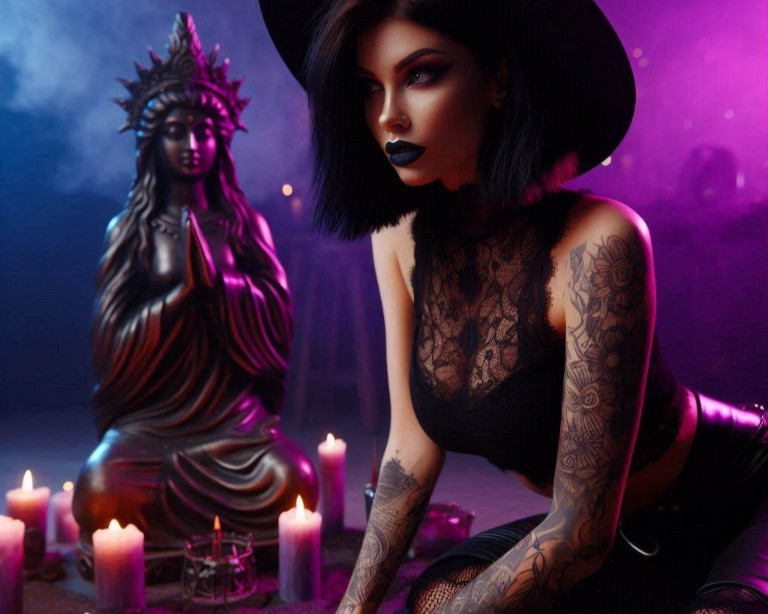
For many Gothic witches, the allure of dark deities from various pantheons is a profound and compelling aspect of their spiritual practice. These deities, often associated with the night, the underworld, and mystery, resonate deeply with the Gothic aesthetic and philosophy. Honoring these deities begins with thorough research. Dive into the rich mythologies and histories of figures like Hecate, the Greek goddess of witchcraft, crossroads, and the night, or Anubis, the Egyptian god of the underworld and protector of the dead. Understanding their stories, attributes, and symbols helps you connect more meaningfully with these powerful entities.
Once you’ve familiarized yourself with these deities, creating altars dedicated to them is a significant step in your practice. An altar is a sacred space where you can focus your energy and intentions. Decorate it with items that represent the deity: statues, symbols, and offerings that they might favor. For Hecate, you might include keys, torches, or images of dogs, which are sacred to her. For Anubis, consider incorporating representations of jackals, funerary objects, or ankh symbols. These physical representations help anchor your spiritual connection and serve as focal points for your rituals and meditations.
Rituals and offerings are essential to honoring these dark deities. Regularly perform rituals that invite their presence and seek their guidance. These can be as simple or elaborate as you feel necessary, from lighting candles and reciting prayers to more complex ceremonies involving specific chants, incense, and sacred movements. Offerings can include food, drink, flowers, or other items that hold significance to the deity. The act of giving is a form of respect and acknowledgment, strengthening your bond with the deity. Pay attention to any signs or messages you receive during these rituals, as they can offer profound insights and guidance.
Building a relationship with dark deities can profoundly deepen your magical practice. These beings, with their connection to the darker aspects of existence, can offer protection, wisdom, and power. By honoring them, you align yourself with their energies, enhancing your own abilities and understanding of the mystical and shadowy realms. This relationship is not just about seeking favors but about mutual respect and learning. As you continue to honor and work with these deities, you’ll likely find your own path becoming clearer and your connection to the spiritual realm growing stronger, enriching your journey as a Gothic witch.
Step 9: Practice Divination
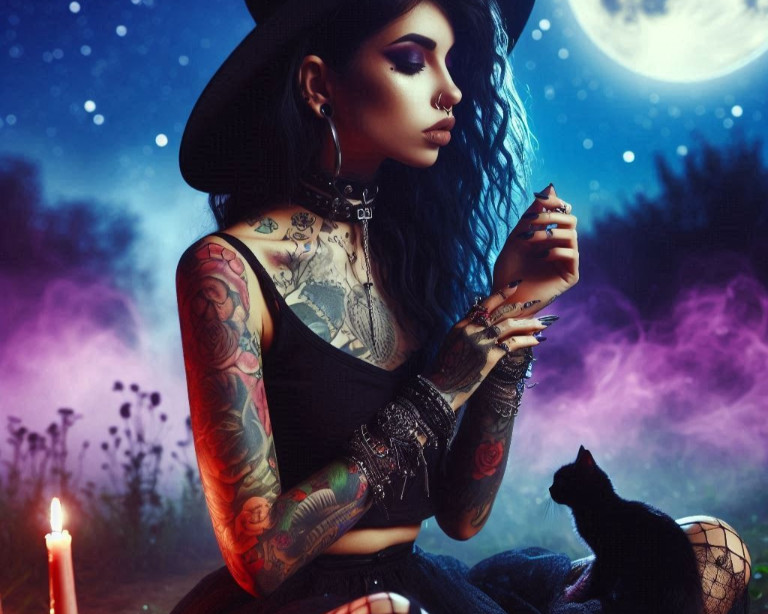
Divination is a fundamental practice within witchcraft, and for the Gothic witch, it carries a uniquely dark and mystical aura. This practice involves seeking knowledge and guidance from the spiritual realm, tapping into unseen forces to gain insight into the future and understand the present more profoundly. The Gothic witch might find themselves particularly drawn to divination tools and methods that resonate with their aesthetic and spiritual leanings. Whether it’s the intricate imagery of tarot cards, the ancient symbols of runes, or the reflective depths of a scrying mirror, these tools become powerful conduits for connecting with the spirit world.
Learning to read tarot cards is a deeply enriching endeavor. Each card is rich with symbolism and meaning, offering layers of insight into various aspects of life. Start by familiarizing yourself with the major and minor arcana, understanding the significance of each card, and practicing simple spreads. As you grow more comfortable, experiment with more complex readings, using your intuition to interpret the cards. The Gothic aesthetic can be infused into your tarot practice through the choice of decks that feature darker, more evocative imagery, enhancing your connection to the cards and the messages they convey.
Casting runes is another potent form of divination. Runes are an ancient alphabet used by Germanic tribes for writing, divination, and magic. Each rune carries a specific meaning and energy, making them powerful tools for seeking guidance. To begin, learn the meanings of each rune and practice simple casts, focusing on one or two runes at a time. Over time, you can develop more elaborate casting methods, using the runes to answer specific questions or provide insights into broader aspects of your life. The tactile nature of the runes, often made from wood or stone, adds a tangible connection to the earth and ancient wisdom, aligning beautifully with the Gothic witch’s reverence for the past.
Using a scrying mirror or crystal ball is another mesmerizing form of divination. These tools involve gazing into reflective surfaces to receive visions or messages from the spirit world. Create a dark, quiet space for your scrying practice, free from distractions. Light candles or burn incense to set the mood, and allow your mind to relax as you gaze into the mirror or crystal. With patience and practice, you may begin to see shapes, symbols, or even scenes unfold before you, providing insights and guidance. Regular practice of divination not only hones your skills but also deepens your connection to the mystical and unseen forces that influence your life, guiding your magical work and personal journey as a Gothic witch.
Step 10: Embrace Your Inner Darkness
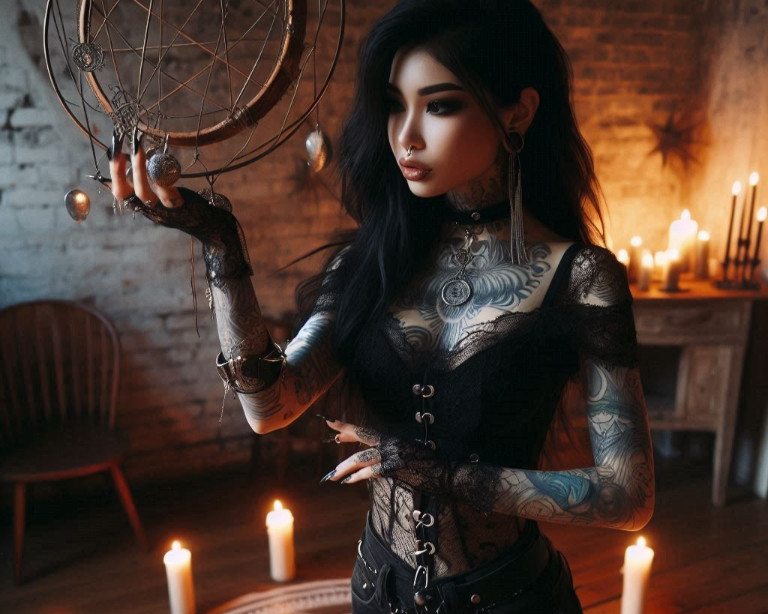
The final step to becoming a Gothic witch is to embrace your inner darkness. This journey is about more than merely accepting the darker aspects of your personality and experiences; it is about integrating them into your whole self, recognizing their value and the strength they can provide. Embracing your inner darkness means confronting the parts of yourself that you might normally shy away from—the fears, insecurities, and shadowy emotions that reside within. By acknowledging these aspects without judgment, you allow yourself to fully understand and harness the power they hold.
Use your magical practice as a tool to explore your inner world. Meditation, shadow work, and journaling are powerful methods for delving deep into your psyche. During these practices, face your fears head-on, and allow yourself to feel and process the emotions that arise. This might involve reliving past traumas or confronting uncomfortable truths about yourself. Through this exploration, you will uncover hidden strengths and wisdom buried within your darkness. Rituals designed to honor and release negative energies can be particularly transformative, helping you to cleanse your spirit and create space for growth and healing.
Transforming your inner darkness into a source of power and wisdom is a key aspect of the Gothic witch’s path. This transformation is not about erasing or denying your darker traits, but rather about finding balance and harmony within yourself. As you integrate these aspects, you will find that they can enhance your magical practice. The depth and complexity of your inner world will enrich your spells and rituals, allowing you to tap into a well of personal power that is uniquely yours. This process of integration also fosters a deep sense of self-awareness and acceptance, which is essential for any witch seeking to wield their magic with confidence and integrity.
By fully embracing your inner darkness, you step into your role as a Gothic witch with authenticity and strength. This acceptance allows you to navigate both the light and dark aspects of the world with wisdom and grace. Your journey becomes one of continuous growth and self-discovery, as you learn to draw strength from all parts of your being. Embracing your inner darkness is a profound act of self-love and empowerment, enabling you to live and practice your craft with a deep sense of purpose and alignment. This final step solidifies your path as a Gothic witch, grounding you in the power of your true, whole self.
Join a Coven
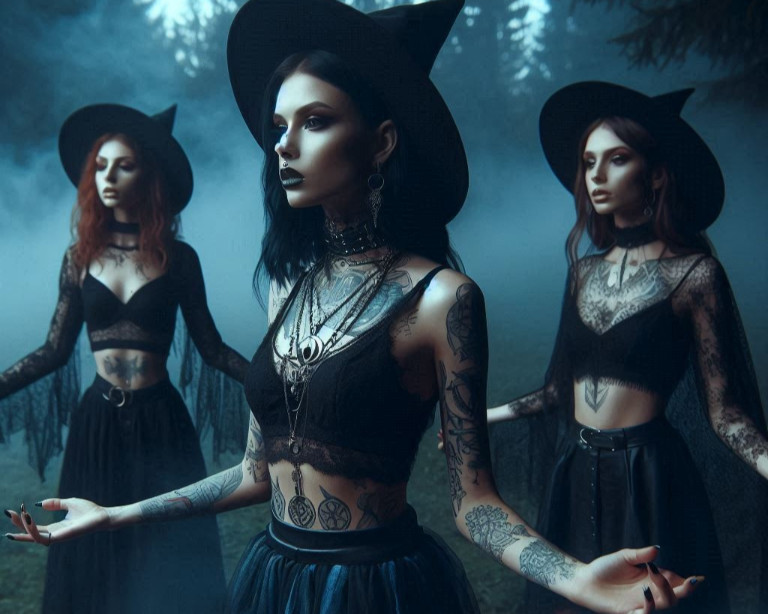
Joining a coven can be a deeply enriching experience for a Gothic witch, providing a sense of community, shared knowledge, and mutual support. Covens are groups of witches who come together to practice their craft, celebrate the Sabbats, and support each other on their magical journeys. For a Gothic witch, finding a coven that shares your aesthetic and magical beliefs can be especially rewarding.
When searching for a coven, look for groups that resonate with your Gothic sensibilities. Many covens have specific themes or focuses, such as traditional witchcraft, Wicca, or eclectic practices. Seek out covens that incorporate elements of Gothic culture, such as dark rituals, moonlit gatherings, and an appreciation for the macabre. Online communities and local metaphysical shops can be great places to start your search.
Once you’ve found a potential coven, take the time to get to know its members and understand its practices and beliefs. Attend open gatherings or events if possible, and ask questions about their rituals, structure, and expectations. It’s important to find a coven where you feel comfortable and where your Gothic witch identity is accepted and celebrated. Trust your intuition and look for a group that feels like a second home.
Joining a coven is not just about finding like-minded individuals; it’s also about contributing your own unique energy and talents to the group. Be prepared to share your knowledge, participate in rituals, and support your fellow coven members. In return, you’ll gain a deeper understanding of your craft, forge meaningful connections, and experience the power of collective magic. A coven can be a source of strength, inspiration, and friendship, enhancing your journey as a Gothic witch.
Practice Goth Witchcraft
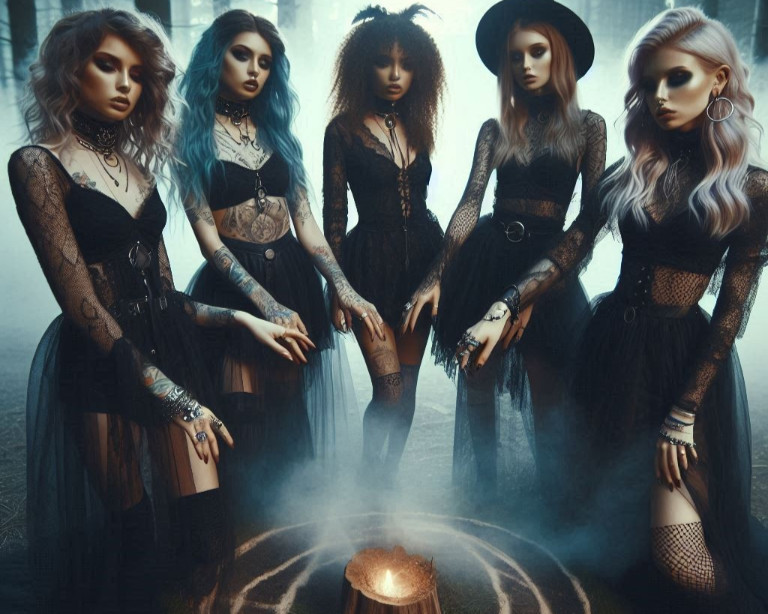
Practicing Goth witchcraft involves infusing your magical practices with the dark, elegant, and mysterious elements of the Gothic aesthetic. This can be done in a variety of ways, from the tools you use to the rituals you perform and the mindset you cultivate. Goth witchcraft is about embracing the beauty of the shadows and finding power in the darkness.
Begin by incorporating Gothic elements into your rituals and spellwork. Use black candles, dark crystals, and antique or Victorian-inspired tools. Perform your rituals at night, preferably under the moonlight, to enhance the mystical atmosphere. Dress in your Gothic attire during your magical practices to help you fully embody the Gothic witch persona. The more you immerse yourself in the Gothic aesthetic, the more powerful and authentic your magic will feel.
Music and ambiance play a crucial role in Goth witchcraft. Create a ritual playlist featuring Gothic rock, darkwave, and ethereal music to set the mood. Light candles, burn incense, and use ambient lighting to create a magical atmosphere. The right environment can help you enter a deeper state of focus and connect more profoundly with the energies you’re working with. Let the music and ambiance transport you to a place where the mundane and the magical converge.
In addition to traditional spellwork, consider exploring the artistic side of Goth witchcraft. Write dark poetry or create art that reflects your magical journey. Use your creative expressions as offerings in your rituals or as tools for meditation and reflection. Art and creativity are powerful ways to channel your magical energy and connect with your inner self. Embrace the melancholy and the beauty of the Gothic aesthetic, allowing it to infuse every aspect of your practice.
Finally, Goth witchcraft is about embracing your personal power and using it to transform your life. Reflect on your fears, your dreams, and the darker aspects of your psyche. Use your magical practice to confront and heal these parts of yourself. By facing your inner darkness, you can turn it into a source of strength and wisdom. Goth witchcraft is a journey of self-discovery, empowerment, and transformation, allowing you to step fully into your power as a Gothic witch.
Choose A Gothic Witch Name

Choosing your Gothic witch name is a deeply personal and mystical journey, reflecting your unique path and connection to the dark and enchanting aspects of the spiritual realm. A Gothic witch name is more than just a title; it is a powerful symbol of your identity, embodying the qualities and energies you wish to embrace. Whether inspired by ancient mythology, dark nature, or the ethereal beauty of the night, your chosen name should resonate with your inner self and the magic you wish to cultivate. This name will become an integral part of your rituals, spells, and personal growth, guiding you as you navigate the shadows and light of your spiritual practice.
When selecting your Gothic witch name, take the time to meditate and reflect on the qualities you hold dear and the energies you wish to invite into your life. Consider names that evoke a sense of mystery, power, and elegance, aligning with your aesthetic and spiritual beliefs. Explore the meanings behind different names, allowing their histories and connotations to inspire you. Whether you are drawn to the fierce protection of Morrigan, the moonlit grace of Luna, or the enchanting allure of Belladonna, your chosen name will serve as a constant reminder of your magical journey and the dark beauty within you.
100 Gothic Name Ideas
Final Musings
Embracing the path of a Gothic witch is a journey into the depths of your soul, where shadows and light dance in an intricate waltz. It is about finding beauty in the darkness, power in the night, and magic in the unseen realms. As you walk this path, remember that the essence of a Gothic witch lies not just in the outward trappings, but in the deep, transformative connection to the mystical and the unknown.
May your journey be filled with wonder, enchantment, and self-discovery. Embrace your inner darkness, celebrate your unique beauty, and let your magic shine through the night. The world of the Gothic witch is rich with mystery and power, waiting for you to step into its embrace. Welcome to the shadows, dear witch, and may your path be ever illuminated by the light of the moon.

